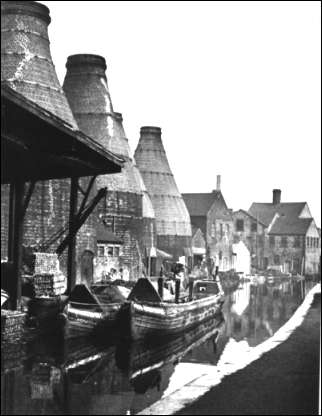Famous Potters of Stoke-on-Trent
![]()
Famous Potters of Stoke-on-Trent
NOTE: Don't confuse J&G Meakin with Alfred Meakin of Tunstall
| J & G Meakin | |
| 1845
saw a partnership between James Meakin and John Proctor at Lane End, Longton. In 1846 James Meakin moved to the Newtown Pottery in Longton and then to Cannon Street in Hanley. |
|
![]() The firm J & G Meakin was founded in 1851 when he was joined by his two sons
James and George. When the father died the business was moved to Market Street,
Hanley.
The firm J & G Meakin was founded in 1851 when he was joined by his two sons
James and George. When the father died the business was moved to Market Street,
Hanley.
![]() The two brothers were quick to realise the potentials of the export market and
the business grew rapidly. George went to America to set up the sales market.
James remained in England and managed the pottery works and the shipping.
The two brothers were quick to realise the potentials of the export market and
the business grew rapidly. George went to America to set up the sales market.
James remained in England and managed the pottery works and the shipping.
 Barges tied up at the J & G Meakin Eastwood Pottery, Hanley. 1952 The canal is the Caldon. |
|

![]() Meakin's main product was white granite dinner and tea ware. The 'Wheat Design'
with its embossed wheat-ears and leaves was an early favourite, since it was
both tough and elegant.
Meakin's main product was white granite dinner and tea ware. The 'Wheat Design'
with its embossed wheat-ears and leaves was an early favourite, since it was
both tough and elegant.
![]() Meakins remained a family form for 100 years and earned a reputation for
treating its employees well. The firm donated £5000 towards Hanley Park
(1892-7), land for the former St. Michael's Church and provided the Organ for
the Victoria Hall, Hanley.
Meakins remained a family form for 100 years and earned a reputation for
treating its employees well. The firm donated £5000 towards Hanley Park
(1892-7), land for the former St. Michael's Church and provided the Organ for
the Victoria Hall, Hanley.
![]() 1968 Meakins joined with Midwinters. In 1970 they were taken over by the
Wedgwood group. The Eagle factory still operates today producing everyday
tableware.
1968 Meakins joined with Midwinters. In 1970 they were taken over by the
Wedgwood group. The Eagle factory still operates today producing everyday
tableware.
|
![]()
![]() Photographs of the Eagle Pottery
Photographs of the Eagle Pottery
![]() Old aerial photographs of the
Eagle Pottery
Old aerial photographs of the
Eagle Pottery
![]() Wedgwood Internet site: www.wedgwood.co.uk
Wedgwood Internet site: www.wedgwood.co.uk
![]()
questions / comments? email: Steve Birks